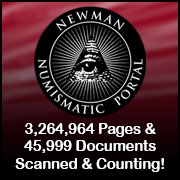
Visit our NBS Sponsors


|
About Us
The Numismatic Bibliomania Society is a non-profit association devoted to the study and enjoyment of numismatic literature. For more information please see our web site at coinbooks.org SubscriptionsThose wishing to become new E-Sylum subscribers (or wishing to Unsubscribe) can go to the following web page link MembershipThere is a membership application available on the web site Membership Application To join, print the application and return it with your check to the address printed on the application. Print/Digital membership is $40 to addresses in the U.S., and $60 elsewhere. A digital-only membership is available for $25. For those without web access, write to: Charles Heck, Treasurer AsylumFor Asylum mailing address changes and other membership questions, contact Chuck at this email address: treasurer@coinbooks.org SubmissionsTo submit items for publication in The E-Sylum, write to the Editor at this address: whomren@gmail.com BUY THE BOOK BEFORE THE COINSale CalendarWatch here for updates! |
- WAYNE'S WORDS: THE E-SYLUM APRIL 11, 2021
- 2021 NBS BOOK SALE CALL FOR DONATIONS
- NEW BOOK: SMALL GERMAN COIN CATALOG
- NEW BOOK: METAL FINDS AND COINS
- BANKNOTE BOOK SIAM, SAINT PIERRE CHAPTERS
- BOOK REVIEW: THE HALF CENT HANDBOOK
- A MYSTERIOUS WHITEHEAD & HOAG TOKEN
- JERSEYANA AND THE NOR*EASTER
- VIDEO: FEBRUARY 2021 COLLECTORAMA COIN SHOW
- MORE ON THE 1792 EAGLE-ON-GLOBE PATTERN
- WHAT CONSTITUTES A DIE VARIETY?
- THE FONROBERT PEACE OF BREDA MEDAL
- SELEUCID TETRADRACHM ISSUED BY DEMETRIUS II
- NOTES FROM E-SYLUM READERS: APRIL 11, 2021
- MORE ON J.N.T. LEVICK
- VOCABULARY TERM: DESIGN COMPETITION
- ISAIAH QUIMBY LUKENS (1779-1846)
- HARVEY STACK'S NUMISMATIC FAMILY, PART 93
- NATANYA VAN NIEKERK ACHIEVEMENT AWARD
- THE NUMISMATIC MUSEUM OF ATHENS
- ALBUM APRIL 2021 E-AUCTION 9 S
- NUMISMATIC NUGGETS: APRIL 11, 2021
- THE COINAGE OF ANCIENT MAURETANIA
- GLACIER ICE SAMPLES TRACK SILVER COIN USE
- MEDIEVAL HOARDS FOUND IN WALES
- THE 1866 NO MOTTO SEATED LIBERTY DOLLAR
- CORNING MAKES GLASS COVID-19 COINS
- THE HISTORY OF INDIA'S PAPER MONEY
- BANKNOTE EMBROIDERY AS POLITICAL ART
- LOOSE CHANGE: APRIL 11, 2021
Click here to read the thin version on the web
Click here to subscribe
Click here to access the complete archive
To comment or submit articles, reply to whomren@gmail.com
Content presented in The E-Sylum is not necessarily researched or independently fact-checked, and views expressed do not necessarily represent those of the Numismatic Bibliomania Society.
WAYNE'S WORDS: THE E-SYLUM APRIL 11, 2021
 New subscribers this week include:
Gregory Hale, courtesy Andrew Crellin;
Frank Sawin, courtesy Tom Caldwell;
Malcolm Webber, courtesy Shanna Schmidt;
Mike Nourse, and
James Rosen.
Welcome aboard! We now have 6,643 subscribers.
New subscribers this week include:
Gregory Hale, courtesy Andrew Crellin;
Frank Sawin, courtesy Tom Caldwell;
Malcolm Webber, courtesy Shanna Schmidt;
Mike Nourse, and
James Rosen.
Welcome aboard! We now have 6,643 subscribers.
Thank you for reading The E-Sylum. If you enjoy it, please send me the email addresses of friends you think may enjoy it as well and I'll send them a subscription. Contact me at whomren@gmail.com anytime regarding your subscription, or questions, comments or suggestions about our content.
This week we open with the NBS book sale, four new books, a review, updates from the Newman Numismatic Portal, and lots of reader comments.
Other topics this week include the 1792 Eagle-on-Globe pattern, die varieties, the Peace of Breda medal, collectors J.N.T. Levick and Robert Coulton Davis, the Numismatic Museum of Athens, the Stephen Album E-Auction, ancient and medieval coinage, the 1866 No Motto dollar, India's paper money, and banknote embroidery art.
To learn more about German coins, the paper money of Saint Pierre and Miquelon, surging numismatic book sales, Tulipmania, the Amon G. Carter, Jr. collection, coin designer Natanya Van Niekerk, Lyndon B. Johnson Hell Banknotes, ancient Mauretania, a glass challenge coin, and counterfeit elephant tokens, read on. Have a great week, everyone!
Wayne Homren
Editor, The E-Sylum
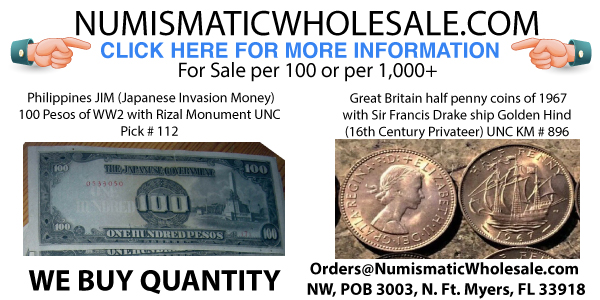
2021 NBS BOOK SALE CALL FOR DONATIONS
Numismatic Bibliomania Society Vice President Len Augsburger submitted this announcement regarding our annual fundraising book auction. Can you help with a donation? -Editor
Numismatic Bibliomania Society Charitable Auction
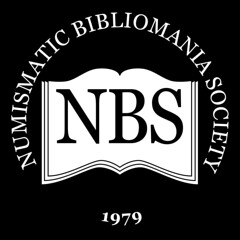 David Fanning has again graciously agreed to coordinate the NBS annual charitable auction. This event will be held at the NBS general meeting at the ANA August convention, or via mail bid if the ANA convention is cancelled. Book donations may be sent to Kolbe & Fanning, 141 W. Johnstown Rd., Gahanna, OH 43230. As the number of lots in the sale is limited, items valued at $100 and up are preferred. Please contact David Fanning prior to sending any shipments, at
df@numislit.com. In order to allow sufficient lead time, please contact David Fanning by June 30.
David Fanning has again graciously agreed to coordinate the NBS annual charitable auction. This event will be held at the NBS general meeting at the ANA August convention, or via mail bid if the ANA convention is cancelled. Book donations may be sent to Kolbe & Fanning, 141 W. Johnstown Rd., Gahanna, OH 43230. As the number of lots in the sale is limited, items valued at $100 and up are preferred. Please contact David Fanning prior to sending any shipments, at
df@numislit.com. In order to allow sufficient lead time, please contact David Fanning by June 30.

NEW BOOK: SMALL GERMAN COIN CATALOG
I don't think we've discussed this one before. Here's a Google-translated description of a new edition from the publisher's website. -Editor
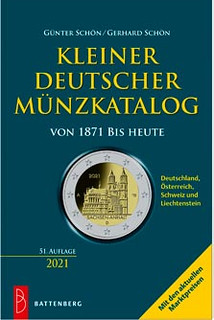 Small German coin catalog from 1871 until today
Small German coin catalog from 1871 until today
Dr. Gerhard Schön | Günter Schön
ISBN: 978-3-86646-200-7
Edition: 51st edition 2021
Images: illustrated in black and white
Softcover: 848 pages
Format: 12.5 x 19 cm For five decades the "Small German Coin Catalog" has been the most popular source of information for collectors of German coins. He is valued above all for the overview of circulation coins, commemorative coins, coin sets, numis sheets and numis letters. All over 3000 coin types are shown in their original size with front and back, all published and announced coin issues are recorded. The actual minting numbers, the current market prices for up to four degrees of preservation (fine, very fine, extremely fine, freshly minted) as well as the production methods stamped gloss and mirror gloss / polished plate are given.
NEW BOOK: METAL FINDS AND COINS
Ted Banning passed along this notice of a new book that might be of interest to readers. Thanks. -Editor
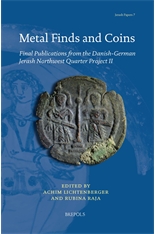 Metal Finds and Coins
Metal Finds and Coins
Final Publications from the Danish-German Jerash Northwest Quarter Project II
A. Lichtenberger, R. Raja (eds.)
XII+182 p., 47 b/w ill. + 19 colour ill., 9 b/w tables, 216 x 280 mm, 2020
ISBN: 978-2-503-58887-2
Languages: English
Paperback
Retail price: EUR 80,00 excl. tax
Website price: EUR 64,00 excl. tax (valid until 26/04/2021)

BANKNOTE BOOK SIAM, SAINT PIERRE CHAPTERS
Owen Linzmayer publishes The Banknote Book, a useful, constantly updated electronic reference. The chapters on the banknotes of Siam (Thailand) and Saint Pierre and Miquelon are now available for $9.99 each. Saint Pierre and Miquelon is a French archipelago south of the Canadian island of Newfoundland. Here's the announcement. -Editor
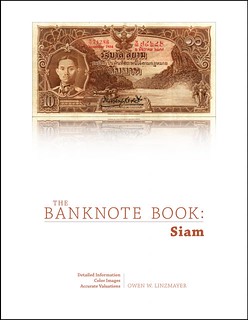
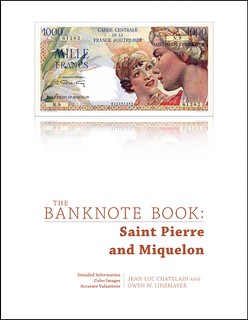
This week it is our pleasure to publish two significant new chapters. The Siam chapter completes coverage of the country that is now known as Thailand. The Saint Pierre and Miquelon chapter documents incredibly rare notes issued more than a century ago in a tiny outpost of the French empire. This is the first chapter co-authored by Jean-Luc Chatelain, who has been instrumental in compiling prefix/series range information throughout The Banknote Book. Enjoy!
THE BOOK BAZARRE
BOOK REVIEW: THE HALF CENT HANDBOOK
Here's an excerpt of a recent CoinWeek review of Ed Fuhrman's new book on Half Cent varieties. -Editor
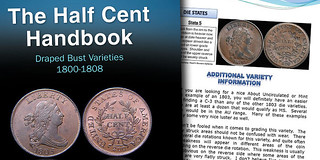 Since its release in 2019, The Half Cent: 1793-1857, self-published by former Early American Coppers (EAC) president William Eckberg, has been a mainstay at the CoinWeek offices for the information it provides on America's "greatest little coin". An update on Breen's outdated work, Eckberg's book is an accessible read – although it is written from Eckberg's particular perspective.
Since its release in 2019, The Half Cent: 1793-1857, self-published by former Early American Coppers (EAC) president William Eckberg, has been a mainstay at the CoinWeek offices for the information it provides on America's "greatest little coin". An update on Breen's outdated work, Eckberg's book is an accessible read – although it is written from Eckberg's particular perspective.
The direction that fellow EAC member Ed Fuhrman advances in his new book, The Half Cent Handbook: Draped Bust Varieties: 1800-1808, is certainly different. While the Fuhrman text is also written in a conversational tone, it focuses on collecting each issue by die variety and die state. That said, there is next to nothing provided here regarding the who, what, when, and why of each variety's creation. Fuhrman preempts this criticism by devoting a single page to lay out what is not covered in his book. Potential buyers should note that Fuhrman's uncovered areas include mintage figures, die variety emission sequences, historical background information, anecdotes about famous collectors, discussion of mint errors, and reverse die rotations for each variety. To us at the CoinWeek offices, these are critical areas of interest, and asking why can a volume cannot also include this information is fair and reasonable, given the title's $105 price.

A MYSTERIOUS WHITEHEAD & HOAG TOKEN
The Newman Numismatic Portal attracts visitors from all over the U.S. and the world. Often their questions are easily answered, but sometimes a mystery lingers. Project Coordinator Len Augsburger has a question to pass on to E-Sylum readers. -Editor
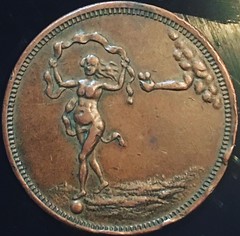
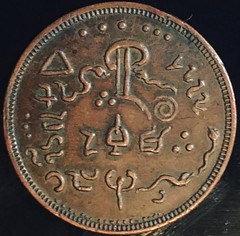
A Mysterious Whitehead & Hoag Token
A Newman Portal user asked about this Whitehead & Hoag Token, which was found in a collection left by her grandfather, a World War II veteran. Whitehead & Hoag were American manufacturers active in the early 20th century, but their records were all later destroyed. Roy Harte reported this piece in Coin World, February 10, 1965, and there suggested the obverse depicted Eve's temptation in the Garden of Eden. The reverse was recently shared with a number of Hebrew scholars, who could identify neither paleo or modern Hebrew characters. Google translate offered inconsistent results when attempting to decipher the reverse characters. Can any E-Sylum readers help?

Images: Whitehead & Hoag token, with closeup of manufacturer's name
Interesting. This has the look of a rebus puzzle, but I'm just as stumped as everyone else. None of this makes any sense to me. But an answer is out there somewhere. Thoughts, anyone? You can click thru on the images to higher-resolution versions on our Flickr archive. -Editor
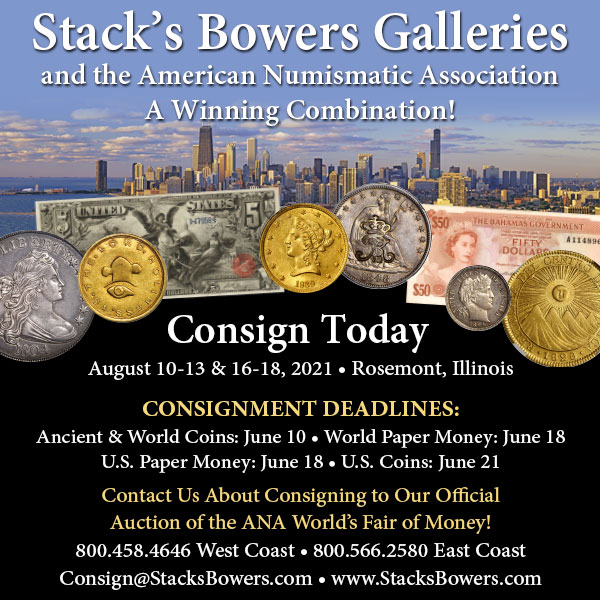
JERSEYANA AND THE NOR*EASTER
David Gladfelter passed along this note about the history of the New Jersey Exonumia Society (1980 to 2010) and its publications Jerseyana and the short-lived The Nor*Easter (now archived on the Newman Portal). Thanks. -Editor
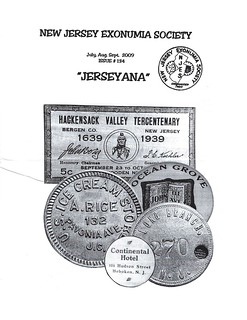
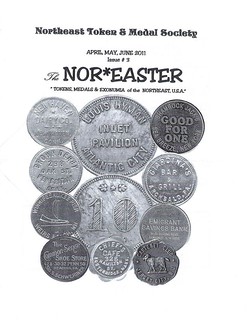
VIDEO: FEBRUARY 2021 COLLECTORAMA COIN SHOW
These are selections from the David Lisot Video Library that feature news and personalities from the world of coin collecting. David has been attending coin conventions since 1972 and began videotaping in 1985. The Newman Numismatic Portal now lists all David's videos on their website at:
https://nnp.wustl.edu/library/multimediadetail/522852
Here's one on the February 2021 Collectorama Coin Show. -Editor
Collectorama Coin Show Offers Collector Haven During COVID February 18, 2021.
VIDEO: 10:51
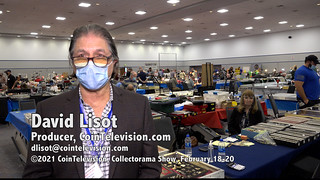 February 18, 2021. David Lisot, Interviewer, CoinTelevision.com, with Rick & Patricia DeSanctis, Larry Garvin, John Bremer, Greg Allen, Robert Calderman, and Audra, Thatcher, & Cutler Emberton.
February 18, 2021. David Lisot, Interviewer, CoinTelevision.com, with Rick & Patricia DeSanctis, Larry Garvin, John Bremer, Greg Allen, Robert Calderman, and Audra, Thatcher, & Cutler Emberton.
People are anxious to get out and go somewhere during the COVID Crisis Pandemic of 2021. What better place to go than to a coin show! But is it safe? David Lisot speaks to participants at the Collectorama Coin & Currency Convention in Lakeland, Florida to find out why people come the show and whether they feel safe. He also speaks to them what is popular for coins and banknotes at the gathering.
An excerpt of the video is available for viewing on the Coin Television YouTube Channel at:
https://youtu.be/OsSOfSmk9eo

MORE ON THE 1792 EAGLE-ON-GLOBE PATTERN
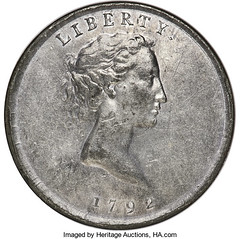
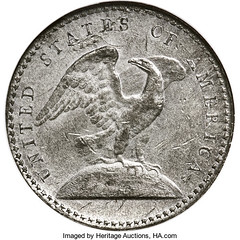

WHAT CONSTITUTES A DIE VARIETY?
Last week Bill Eckberg asked:
"What Constitutes a Die Variety?
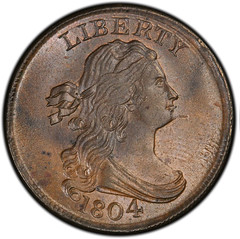 "I have talked to guys who say a die is a piece of metal, and if somebody recuts something or changes something it's the same die. Others think that even the tiniest change, like the strength of a berry stem makes for a new variety.
"I have talked to guys who say a die is a piece of metal, and if somebody recuts something or changes something it's the same die. Others think that even the tiniest change, like the strength of a berry stem makes for a new variety.
"Personally, I think any alteration has to be significant and not accidental. In the half cent world, the 1795 no-pole obverse is just a reground with-pole obverse that was used earlier. Similarly, the Spiked Chin obverse was apparently the result of some kind of damage. I consider both of those to be die states after their alteration, whether intentional or accidental."

THE FONROBERT PEACE OF BREDA MEDAL
Last week Dave Hirt asked about Lot #2920 on the 1878 Jules Fonrobert sale of coins, tokens, and medals of North America. A silver piece listed under New York City is described as follows (in German). Thanks to Ron Haller-Williams for the image. -Editor
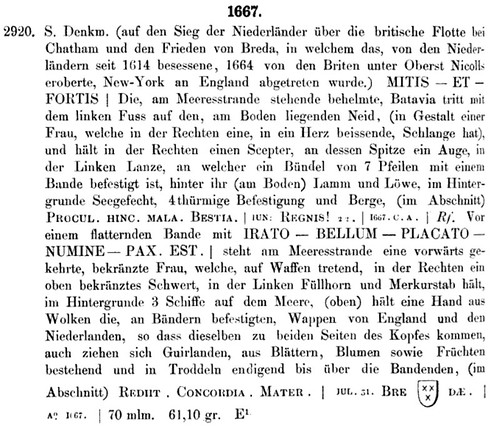

SELEUCID TETRADRACHM ISSUED BY DEMETRIUS II
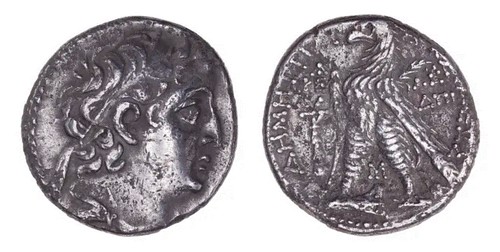
Russell Atherton writes:
"Interesting and significant fact about the coin featured in "Second Temple Period Shekel Rediscovered": It isn't a Tyrian shekel. It is a Seleucid tetradrachm issued by Demetrius II. It looks quite similar to the civic issues with the Melqart obverse, but the obverse is a portrait of Demetrius II. In fact, his name is clearly included on the reverse -- which of course never appears on the coins known as Tyrian shekels.
Thanks for your faithful work in compiling this excellent weekly resource!"

NOTES FROM E-SYLUM READERS: APRIL 11, 2021
More on Those Love Tokens on Counterfeit Quarters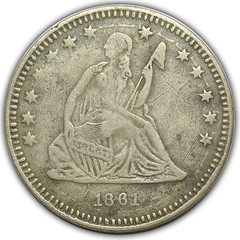
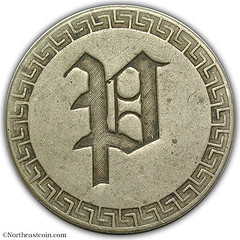
Regarding Jeremy Bostwick's article on the Love Token on counterfeit 1861 Seated Liberty Quarters, Tom Caldwell of Northeast Numismatics writes:
Of the examples presented ours seems to be the only one that was not used as jewelry. Guessing other letters of the alphabet will show up. The explanation of it being a cottage industry makes a lot of sense."
Thanks for passing along the original item. Interesting story! -Editor
To read the earlier E-Sylum articles, see:
NOTES FROM E-SYLUM READERS: MARCH 28, 2021 : Love Token on Counterfeit Seated Quarter
(https://www.coinbooks.org/v24/esylum_v24n13a11.html)
LOVE TOKENS ON COUNTERFEIT SEATED QUARTERS
(https://www.coinbooks.org/v24/esylum_v24n14a08.html)
Other topics this week include medal maker Wendell's, and Prince Philip. -Editor

MORE ON J.N.T. LEVICK
Dave Hirt submitted these additional thoughts on J.N.T. Levick. Thanks! -Editor
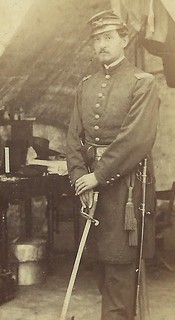 First of all I want to congratulate Pete Smith for his interesting, but sad article, "The Coin Shop Killer", published in The Numismatist magazine that I received in the mail this week.
First of all I want to congratulate Pete Smith for his interesting, but sad article, "The Coin Shop Killer", published in The Numismatist magazine that I received in the mail this week.
On the John Lupia bio of JNT Levick, he was a super collector and numismatist. it was a surprise to me that he owned the Oak and Pine Tree coins from the Roxbury hoard. The letter to Tom Elder on his house full of collectables was covered in the The E-Sylum some years ago. All I can say is that Levick must have had a very understanding wife!
The 20,000 token collection sold by Woodward in 1884 speaks for itself. He had everything! In the AJN, the report of the Jan. 1878 meeting of the Boston Numismatic Society reports that the president had received a parcel of coins belonging to JNT Levick, of many rare pieces, including a 1802 Half Dime, Threepence of Standish Berry, five varieties of Wolfe, Spies, and Clark tokens, Ricketts Circus tokens in silver and copper, Washington market chowder club token, several California private issues, and a number of other rare tokens.
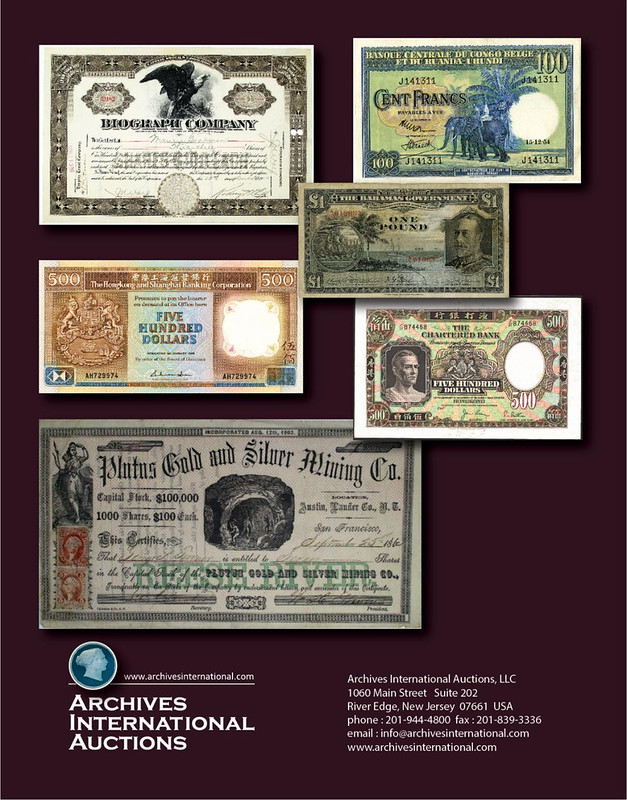
VOCABULARY TERM: DESIGN COMPETITION
Here's another entry from Dick Johnson's Encyclopedia of Coin and Medal Terminology. -Editor
Design Competition. A contest to obtain a desired coin or medal design. There are two kinds: open and closed. Anyone from the public is allowed to enter an open competition; entries come from the most competent professional artist to the most amateurish, childish contestant. A closed competition is available only to those who are so invited by the sponsor, often for a fee and irrespective of the outcome of the contest. While most professional artists refuse to enter an open contest, considering it a waste of their time and talent, they will readily accept participating in a closed competition.
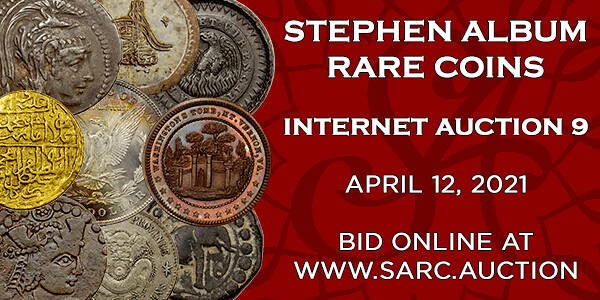
ISAIAH QUIMBY LUKENS (1779-1846)
Here's another entry from the online draft of John Lupia's book of numismatic biographies. Thanks! This is an excerpt with the full article and bibliography available online. This week's subject is Isaish Lukens of Philadelphia, an early American coin collector. -Editor
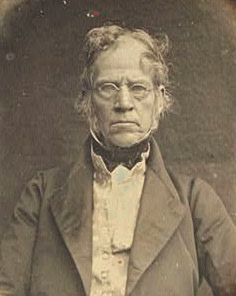 Lukens, Isaiah Quimby (1779-1846), Philadelphia inventor, machinist, gun and clock-maker. He was born at Horsham, Pennsylvania on April 24, 1779, the second son of ten children born to Seneca Iredell Lukens (1751-1829) a clockmaker and Sarah Quimby (1755-1843). His father taught him the mechanical skill and craft of being a machinist and in the fine art of clock-making.
Lukens, Isaiah Quimby (1779-1846), Philadelphia inventor, machinist, gun and clock-maker. He was born at Horsham, Pennsylvania on April 24, 1779, the second son of ten children born to Seneca Iredell Lukens (1751-1829) a clockmaker and Sarah Quimby (1755-1843). His father taught him the mechanical skill and craft of being a machinist and in the fine art of clock-making.
He made the clock for the Old State House "Independence Hall" in Philadelphia in 1828. It was removed in 1924 and installed in the new Town Hall at Germantown. He was one of the founders of the Franklin Institute, and was elected its first Vice-President.
He died of an aneurysm of the aorta on November 12, 1846, at Philadelphia, Pennsylvania. He is buried at Laurel Hill Cemetery, Philadelphia, Pennsylvania.

HARVEY STACK'S NUMISMATIC FAMILY, PART 93
The latest article in Harvey Stack's blog series discusses the 1984 sale of the Amon G. Carter, Jr. collection. Thanks. -Editor
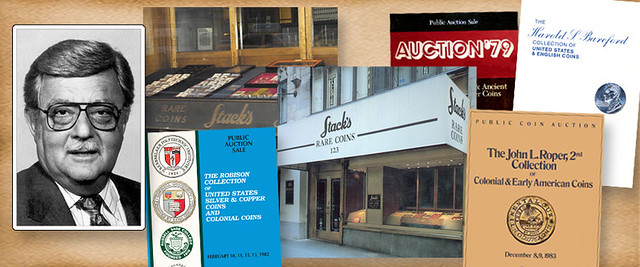
To start off our landmark auction year in 1984 Stack's presented the astounding coin collection of Amon G. Carter, Jr. This collection had been started by Amon Carter, Sr. and later enhanced by his son. The Carter family owned the Fort Worth Star Journal, was a major shareholder of American Airlines, and in 1953 the Amon Carter Field airport was opened in Fort Worth.

NATANYA VAN NIEKERK ACHIEVEMENT AWARD
The Lifetime Achievement Award in Coin Design is given annually as part of Coin of the Year awards program recognizing excellence and ingenuity in coin design. A Numismatic News article by Tom Michael discusses this year's winner Natanya Van Niekerk. Here's an excerpt, but be sure to read the complete article online. -Editor
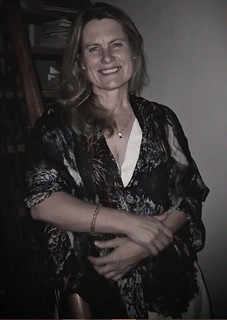 After 27 years of experience in the coin and bullion industry, Natanya Van Niekerk has left her distinctive artistic mark on both legal tender coins and investment bullion pieces. She has experienced the inner workings of our industry at the national mint, private mint and refinery levels. The constant in each of those channels was that Van Niekerk pursued a holistic approach to precious metal design, combining politics, environment and art.
After 27 years of experience in the coin and bullion industry, Natanya Van Niekerk has left her distinctive artistic mark on both legal tender coins and investment bullion pieces. She has experienced the inner workings of our industry at the national mint, private mint and refinery levels. The constant in each of those channels was that Van Niekerk pursued a holistic approach to precious metal design, combining politics, environment and art.
This approach guided Van Niekerk in the creation of almost 20 award-winning coin designs, from 1996 to 2013, including nine Mint Directors Conference (MDC) awards and three Coin of the Year (COTY) category awards, two of which went on to win the overall COTY in the 1999 and 2011 competitions. But this recognition did not appear overnight, as Van Niekerk reminded us in her acceptance speech for the 2021 COTY Lifetime Achievement Award in Coin Design, her career has been a process.
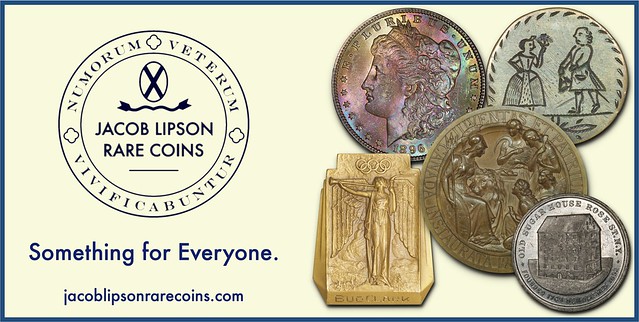
THE NUMISMATIC MUSEUM OF ATHENS
For those itching to plan some post-pandemic travel, here's something for numismatists to consider - the numismatic museum in Athens, Greece. From the Greek City Times. -Editor
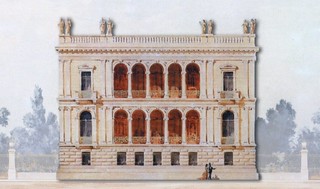 A priceless treasure in the heart of Athens, the Numismatic Museum pays tribute to Greece's integral role in the intricate history of coinage, serving as a key source of information on matters of economy from antiquity and beyond.
A priceless treasure in the heart of Athens, the Numismatic Museum pays tribute to Greece's integral role in the intricate history of coinage, serving as a key source of information on matters of economy from antiquity and beyond.
Housing a collection of over 500,000 coins, medals, gems, weights, stamps and related artefacts from the 14th century BC to modern times, this collection constitutes one of the richest in the world, paralleled by those of the British Museum in London, the Bibliothèque Nationale in Paris, the State Hermitage Museum in St. Petersburg, the Bode Museum in Berlin, and the American Numismatic Society in New York.
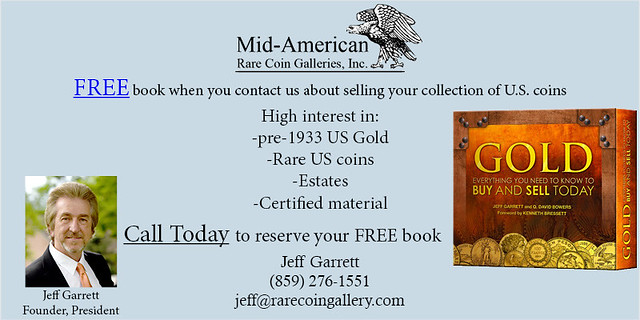
ALBUM APRIL 2021 E-AUCTION 9 S
Here's the press release for the April 2021 E-Auction 9 sale from Stephen Album Rare Coins. Get your bids in quick! -Editor
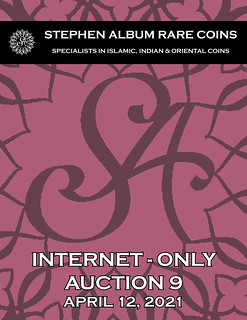 Stephen Album Rare Coins will hold its Internet Auction 9 on April 12, 2021. The firm has plans to conduct monthly internet auctions each of the 9 months of the year when its larger floor auctions are not being held. The larger sales are routinely held in January, May and September.
Stephen Album Rare Coins will hold its Internet Auction 9 on April 12, 2021. The firm has plans to conduct monthly internet auctions each of the 9 months of the year when its larger floor auctions are not being held. The larger sales are routinely held in January, May and September.
Pre-sale bidding has already begun and will continue through April 12. At that point it will be possible to bid live online to compete with others bidders for the offerings. The auction is made up of exactly 600 lots of Ancient, Islamic, Chinese, General World, and Indian Coins, with starting prices from $25 to $1,600.

NUMISMATIC NUGGETS: APRIL 11, 2021
Here's a selection of interesting or unusual items I came across in the marketplace this week. Tell us what you think of some of these. -Editor
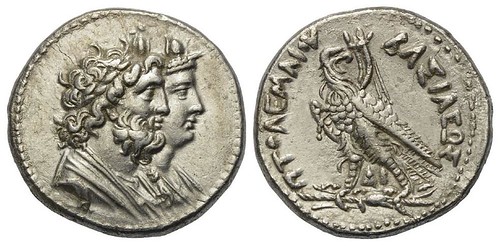
Lot 1167. Ptolemaic Kingdom. Ptolemy IV Philopator (221-205 BC).
Tetradrachm (silver). After 217 BC Chr. Alexandria. Vs: The draped busts of Zeus Serapis with a laurel wreath, Tainia and Atef crown and Isis with a wreath of ears and a crown side by side on the right. Rs: eagle with flared wings and double horn of plenty standing on lightning bundle to the left, head turned to the right; between the legs delta-iota.
Above is the Google-translated version of the lot description. Great double bust. -Editor
To read the complete lot description, see:
Lot 1167. Ptolemäisches Königreich. Ptolemaios IV. Philopator (221 - 205 v. Chr.).
(https://www.sixbid.com/en/solidus-numismatik/8353/griechische-mnzen/6920493/ptolemisches-knigreich-ptolemaios-iv-philopator)
Other topics this week include Queen Victoria, Curling Club medals, and Lyndon B. Johnson Hell Banknotes. -Editor
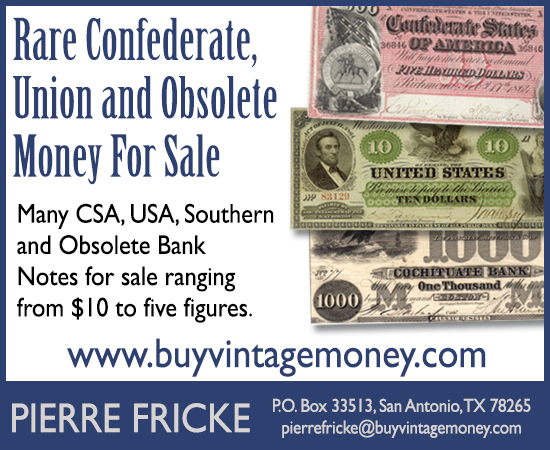
THE COINAGE OF ANCIENT MAURETANIA
Mike Markowitz has published another great article in his CoinWeek Ancient Coin Series. There's always much to learn from his well-researched pieces, and the great images are a delight, whether one collects ancient coinage or not. Here's a short excerpt - be sure to see the complete article online. -Editor
ANCIENT MAURETANIA WAS a region of coastal North Africa stretching from modern-day Algeria to Morocco. It should not be confused with the modern West African nation of Mauritania (spelled differently). The inhabitants of Mauretania were ancestors of the modern people known as Berbers. The Greeks knew them as Mauroi (?a????). To the Romans, they were Mauri. This term comes into English as "Moor", a name that has been applied to a variety of African people; for example, Shakespeare's Othello, the "Moor of Venice."
Bocchus I
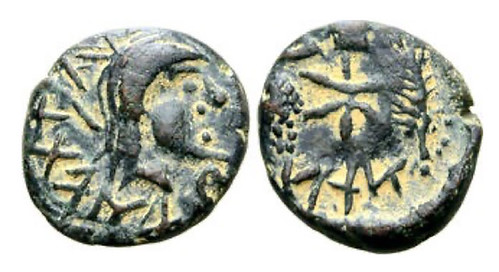
The earliest king of Mauretania known to history was Baga, who ruled c.225 BCE from his capital of Chellah (near Rabat, Morocco). The first ruler for whom we have coins was probably Bocchus (or Boccus), who reigned from about 111 to 80 BCE. Some very crude bronze coins are attributed to Bocchus (or possibly his son). A "half unit" of 4.5 grams shows a long-haired bearded head in profile on the obverse and a star between a cluster of grapes and an ear of grain on the reverse. A "unit" of about 9.4 grams shows the same obverse portrait, with a standing figure on the reverse.
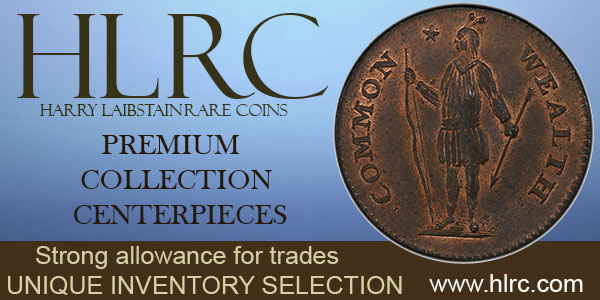
GLACIER ICE SAMPLES TRACK SILVER COIN USE
Len Augsburger passed along this 2018 Science Magazine article about the darkest hours of the Dark Ages. -Editor
Ask medieval historian Michael McCormick what year was the worst to be alive, and he's got an answer: "536." Not 1349, when the Black Death wiped out half of Europe. Not 1918, when the flu killed 50 million to 100 million people, mostly young adults. But 536. In Europe, "It was the beginning of one of the worst periods to be alive, if not the worst year," says McCormick, a historian and archaeologist who chairs the Harvard University Initiative for the Science of the Human Past.
THE BOOK BAZARRE
MEDIEVAL HOARDS FOUND IN WALES
Here's a story of some interesting small hoard finds in Wales. Cool skull ring. Found via The Explorator newsletter. To subscribe to Explorator, send a blank email message to: explorator+subscribe@groups.io. -Editor
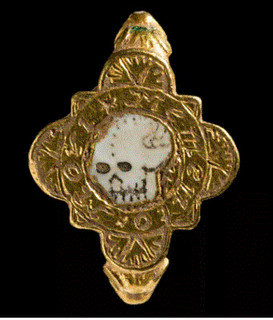 Metal detectorists in Wales have unearthed nine priceless valuables dating to the medieval and post-medieval periods, including a gold ring decorated with a spooky-looking skull crafted from white enamel.
Metal detectorists in Wales have unearthed nine priceless valuables dating to the medieval and post-medieval periods, including a gold ring decorated with a spooky-looking skull crafted from white enamel.
After analyzing the curios, Graeme David Hughes, the senior coroner for South Wales Central in the United Kingdom, officially declared them to be "treasures," a term that refers to bonafide, often metal artifacts that meet a specific archaeological criteria, according to the U.K.'s Portable Antiquities Scheme.
In all, these treasures include three hoards of gold and silver coins, gold and silver rings, and personal items worn by upper-class members of Welsh society from the ninth to the 17th centuries A.D., according to a statement from the Amgueddfa Cymru — National Museum Wales released March 29.

THE 1866 NO MOTTO SEATED LIBERTY DOLLAR
David Stone of Heritage Auction published a nice article on the 1866 No Motto Seated Liberty dollar. Reprinted with permission from The Intelligent Collector magazine (IntelligentCollector.com) - Spring 2021 issue. Thanks! -Editor
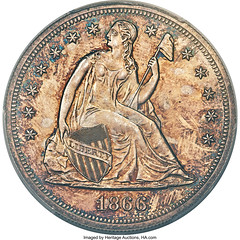
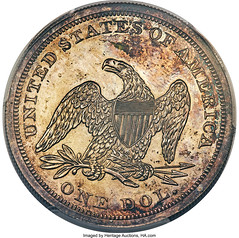
With only two examples known to collectors today, the 1866 No Motto Seated Liberty dollar is so rare that most collectors tend to overlook the issue. When discussing the rarest and most valuable U.S. coins, the conversation usually focuses on more famous issues, like the 1804 dollar (15 examples known), the 1913 Liberty nickel (five specimens extant) or the 1894-S Barber dime (nine survivors known). The much more elusive 1866 No Motto dollar is seldom mentioned, as its public offerings occur so infrequently that the coin remains out-of-sight and out-of-mind for most collectors. Its availability is further diminished because one of the two known specimens is impounded in the National Numismatic Collection at the Smithsonian Institution, where no collector will ever acquire it.
Against this backdrop of relative anonymity, Heritage Auctions is offering the only available example of this overlooked rarity in its April 2021 catalog of Important Selections from the Bob R. Simpson Collection, Part V. Hopefully, this high-visibility appearance will increase collector interest in the 1866 No Motto dollar, one of the rarest issues in American coinage.

CORNING MAKES GLASS COVID-19 COINS
Nick Graver of Rochester, NY passed along this article about the Corning Museum's new glass challenge coins to celebrate the National Guard campaign over the making of the glass vials that hold the Covid Vaccine. Thanks! -Editor
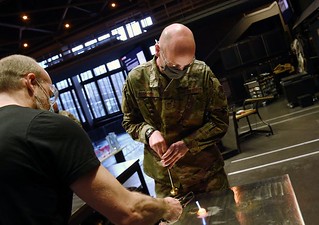 Corning Inc. is a major player in the battle to defeat the COVID-19 pandemic, and the New York Army National Guard is manning a state-run regional vaccination center at SUNY Corning Community College.
Corning Inc. is a major player in the battle to defeat the COVID-19 pandemic, and the New York Army National Guard is manning a state-run regional vaccination center at SUNY Corning Community College.
Now the Corning Museum of Glass is creating a special commemorative coin to honor both of those efforts.
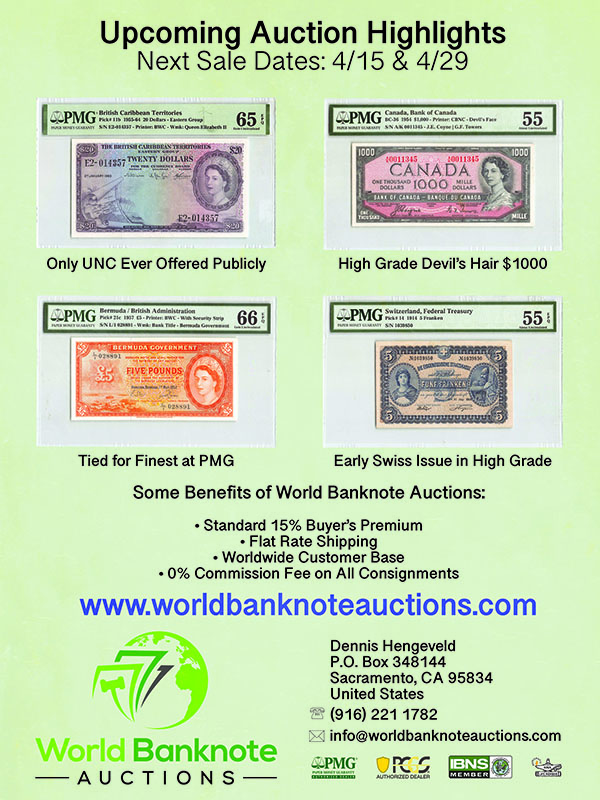
THE HISTORY OF INDIA'S PAPER MONEY
This article from the Hindistan Times seems like a nice overview of the history of the paper money of India, along with some insight on Britain's experience with its American colonies. Found via News & Notes from the Society of Paper Money Collectors (Volume VI, Number 41 March 30, 2021). -Editor
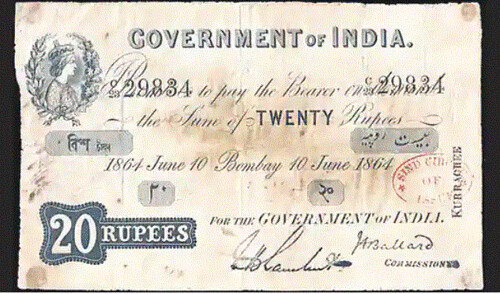
1864 Government of India 20 Rupees note
Indian paper money is 160 years old this month. See how an act meant to tighten British control ended up uniting us in spirit, then and even today.

BANKNOTE EMBROIDERY AS POLITICAL ART
There are nearly as many forms of Money Art as there are Money Artists like my old friend J.S.G. Boggs. This article from The Guardian introduced me to something I hadn't heard of before - embroidered banknotes. Interesting concept. Here are some designs that caught my eye - see the complete article for more. -Editor
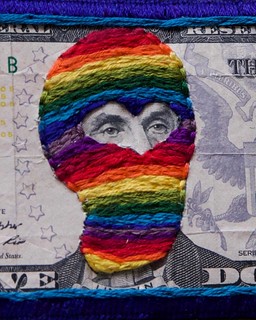 American artist Stacey Lee Webber has embroidered money for more than a decade. She started as a way to question the value of work by meticulously stitching patterns on to worthless one dollar bills. The latest incarnation – the Insurrection Bills – is a response to the US's febrile political climate.
American artist Stacey Lee Webber has embroidered money for more than a decade. She started as a way to question the value of work by meticulously stitching patterns on to worthless one dollar bills. The latest incarnation – the Insurrection Bills – is a response to the US's febrile political climate.

LOOSE CHANGE: APRIL 11, 2021
Here are some additional items in the media this week that may be of interest. -Editor
Canadian Coin News reports that the Ontario Numismatic Association will hold a numismatic symposium online. -Editor
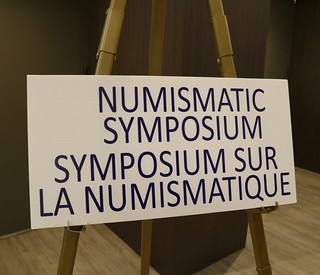 The Ontario Numismatic Association (ONA) will host its first virtual convention on April 9-11, the same dates as the since-cancelled in-person gathering originally slated for Burlington.
The Ontario Numismatic Association (ONA) will host its first virtual convention on April 9-11, the same dates as the since-cancelled in-person gathering originally slated for Burlington.
The decision to move the three-day convention to a digital format came in mid-January, when ONA officials met to discuss the ongoing COVID-19 pandemic, which has now forced the provincial association to cancel two of its yearly conventions. This April's virtual convention – the first hosted by a major Canadian numismatic organization – will feature most aspects of a typical in-person convention other than the bourse, exhibits and social functions.
To read the complete article, see:
First virtual ONA Convention free, open to everyone
(https://canadiancoinnews.com/first-virtual-ona-convention-free-open-to-everyone/)
Other topics this week include counterfeit Elephant tokens, and digital payments. -Editor


